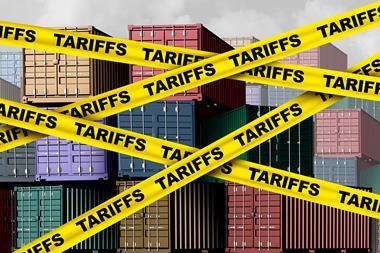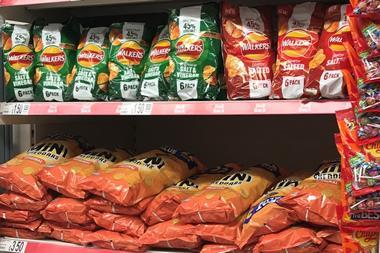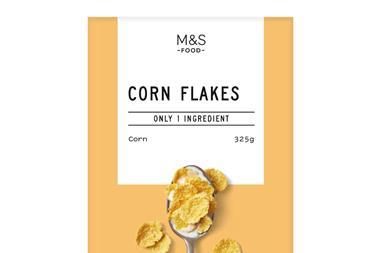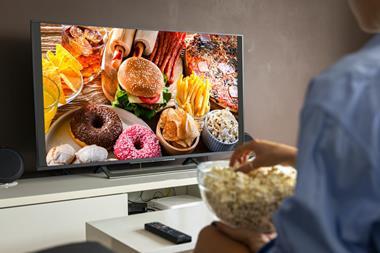So, the deed is done. From 1 April, Ofcom's clampdown on junk food advertising to children under 16 is a legislative reality. But is this the end of the food and drink industry's woes? Is this as bad as it's going to get? Not likely.
For many brands that children have thrived on for years, and even for new products developed with health in mind, further persecution awaits.
The worst-case scenario sees cheese, raisins, honey, Marmite, yoghurt, olive oil, low-fat spreads, ketchups, jams and fruit juice-based sweets classed alongside cigarettes and alcohol with government health warnings.
Does this seem to you like scaremongering? Could we really one day see health warnings like this on our food? In fact it's happening already (in a less extreme form, perhaps) with the Food Standards Agency's traffic-light labelling scheme with red lights.
At the moment, of course, this is a voluntary scheme. And Dame Deirdre Hutton, chair of the FSA, has been saying in public that consumers will decide if it will triumph over the rival Guideline Daily Amounts (GDA) scheme launched by the Food and Drink Federation. But in private Dame Deirdre is said to be lobbying furiously for Europe to make the scheme compulsory. Many believe this would be a disaster for consumer understanding of what constitutes a healthy, balanced diet.
James Paice, shadow minister for agriculture and rural affairs, this week added his voice to the many supporting The Grocer's Weigh It Up! campaign.
He says traffic-light labelling, like the FSA's Nutrient Profiling Model, attempts to put things into "neat pigeonholes" but doesn't take into account how people actually eat in the real world. He warns that the two systems could easily become linked in consumers' minds.
They will see that cheese is banned from advertising to children and that it carries red traffic-light labelling and assume it is bad for them, he warns, adding: "This is worrying."
However, despite these kinds of concerns, even compulsory labelling may not be enough to assuage the quangos, NGOs and other lobbying groups. With experts placing the cost of obesity at £7bn a year to the government - it is already way above the combined costs to the NHS of smoking and alcohol-related problems, which each cost the UK an estimated £1.7bn a year - food is starting to take on a demonic status to rival and quite possibly even trump cigarettes. Experts are warning this month that obesity could bankrupt the NHS if left unchecked and predict that the proportion of obese adults will rise from one in five to one in three by 2010.
In the light of this, Ofcom's junk food advertising ban to children is indeed the thin end of the wedge.
As well as using the Nutrient Profiling Model to underpin an advertising ban, the FSA is also suggesting it be used to demonstrate which products on children's menus are suitable for consumption, a move that would have a dramatic effect on any restaurant that sells breakfast.
The latest, gravest fear among industry and nutrition experts is that the model could form the basis of a system being developed at EU level to restrict the use of health and nutrition labelling claims by foods that are high in fat, salt and sugar (HFSS).
This is why The Grocer is calling for an urgent review of the FSA's junk food scoring system. We have serious concerns about the classification of healthy, natural products such as cheese, honey, Marmite, raisins and over 80% of breakfast cereals as 'junk food'. Other products caught up include olive oil, low-fat margarine and low-sugar sweets.
If the model is used to justify health and nutrition labels, however, cheese, Marmite, honey, raisins and these other products won't just be banned from advertising to kids. They will be prevented from making any health claims to anyone.
How serious is this threat? The European Commission has already indicated that it is keen on some form of nutrient profiling and wants to have it in place by January 2009.
The Commission has asked the European Food Safety Authority (EFSA) to come up with a basis for nutrient profiling by January next year and to advise on the choice and balance of nutrients to be taken into account, how they will be scored, plus the feasibility of any system. "The application of nutrient profiling as a criterion would aim to avoid a situation where nutrition or health claims mask the overall nutritional status of a food product, which could mislead consumers when trying to make healthy choices in the context of a balanced diet," it says.
Dame Deirdre is deputy chair of the EFSA. Industry insiders say the FSA is pushing hard for its own profiling system to be chosen. If the FSA's model is used as the basis for the European health and nutrition labelling scheme, foods failing to pass its junk food classification would be unable to make any on-pack health claims to any age groups even if they contained high levels of beneficial vitamins or minerals.
The Commission promises consultation with interested parties - in particular the food industry and consumer groups. There are also indications that it may consider various exemptions to allow foods to take vitamin, mineral and calcium content into account. Let's hope this is the case.
Dr Judith Bryans, director of the Dairy Council, who also holds a PhD in human nutrition, voices the concerns of many experts when she says: "There are a number of groups around Europe who are developing models to submit to the EFSA for consideration.
"Many of these models have been developed following analysis of the FSA's model and the anomalies it throws up. Obviously some means of deciding which foods can and can't carry claims are needed in order to regulate their use.
"However, any profiling system developed for use in the regulation of health claims will have to be robust and since many of the claims people will want to make will be based on positive nutrients, there is no point in having a model that doesn't award scores for these."
Gaynor Bussell, the Food and Drink Federation's nutrition manager, adds: "It would be particularly worrying if the FSA model were used for health claims because it would not encourage product innovation in some food categories. The whole point of a nutrient claim is to highlight to consumers when the manufacturer has significantly reduced the level of certain nutrients of concern or added to it, but this will not be possible to do if a reformulated product fails the profiling model. The FDF looks to EFSA to take a science-based approach in its examination of the feasibility of developing a scheme for use in relation to the Health & Nutrient Claims Regulation."
Certainly brands such as the recently reformulated Dairylea Lunchables, which now have higher calcium and vitamin D content, would not be allowed to flag their benefits on pack under the current FSA model if it were applied by the EC.
Meanwhile the industry is on tenterhooks waiting to find out how the Advertising Standards Authority intends to apply the broad meaning of the Ofcom rules to non-broadcast media.
The Committee for Advertising Practice was expected to meet last week to thrash out content rules for poster and cinema campaigns and press advertising, but the meeting was postponed until after Ofcom's final ruling last Thursday, which finally confirmed the ad ban would extend to under 16s and not just under nines as originally tabled.
A new date for CAP's meeting had yet to be set when The Grocer went to press but the proposals are, if anything, even more draconian.
Under the ASA's proposals, the industry is expecting ALL food aimed at children, regardless of its nutrient profile, to be banned from using celebrities, licensed characters and free gifts appealing to kids in its non-broadcast campaigns later this year. However, an ASA spokesperson would only say that until the CAP had met, nothing was to be decided.
The food industry is determined to continue its lobbying of the FSA and Parliament. However, senior figures who have talked to politicians on both sides of the political divide say there is a reluctance for any of them to put their heads above the parapet and be seen supporting the food industry.
One industry source summed it up nicely: "The food industry is worth 15% of GDP but no one in the government is taking an interest in food companies. All they care about is meeting their targets to cut obesity.
"That's all it's about these days - meeting targets. They'd rather push food issues to quangos such as the FSA and let them take the flak."n
For many brands that children have thrived on for years, and even for new products developed with health in mind, further persecution awaits.
The worst-case scenario sees cheese, raisins, honey, Marmite, yoghurt, olive oil, low-fat spreads, ketchups, jams and fruit juice-based sweets classed alongside cigarettes and alcohol with government health warnings.
Does this seem to you like scaremongering? Could we really one day see health warnings like this on our food? In fact it's happening already (in a less extreme form, perhaps) with the Food Standards Agency's traffic-light labelling scheme with red lights.
At the moment, of course, this is a voluntary scheme. And Dame Deirdre Hutton, chair of the FSA, has been saying in public that consumers will decide if it will triumph over the rival Guideline Daily Amounts (GDA) scheme launched by the Food and Drink Federation. But in private Dame Deirdre is said to be lobbying furiously for Europe to make the scheme compulsory. Many believe this would be a disaster for consumer understanding of what constitutes a healthy, balanced diet.
James Paice, shadow minister for agriculture and rural affairs, this week added his voice to the many supporting The Grocer's Weigh It Up! campaign.
He says traffic-light labelling, like the FSA's Nutrient Profiling Model, attempts to put things into "neat pigeonholes" but doesn't take into account how people actually eat in the real world. He warns that the two systems could easily become linked in consumers' minds.
They will see that cheese is banned from advertising to children and that it carries red traffic-light labelling and assume it is bad for them, he warns, adding: "This is worrying."
However, despite these kinds of concerns, even compulsory labelling may not be enough to assuage the quangos, NGOs and other lobbying groups. With experts placing the cost of obesity at £7bn a year to the government - it is already way above the combined costs to the NHS of smoking and alcohol-related problems, which each cost the UK an estimated £1.7bn a year - food is starting to take on a demonic status to rival and quite possibly even trump cigarettes. Experts are warning this month that obesity could bankrupt the NHS if left unchecked and predict that the proportion of obese adults will rise from one in five to one in three by 2010.
In the light of this, Ofcom's junk food advertising ban to children is indeed the thin end of the wedge.
As well as using the Nutrient Profiling Model to underpin an advertising ban, the FSA is also suggesting it be used to demonstrate which products on children's menus are suitable for consumption, a move that would have a dramatic effect on any restaurant that sells breakfast.
The latest, gravest fear among industry and nutrition experts is that the model could form the basis of a system being developed at EU level to restrict the use of health and nutrition labelling claims by foods that are high in fat, salt and sugar (HFSS).
This is why The Grocer is calling for an urgent review of the FSA's junk food scoring system. We have serious concerns about the classification of healthy, natural products such as cheese, honey, Marmite, raisins and over 80% of breakfast cereals as 'junk food'. Other products caught up include olive oil, low-fat margarine and low-sugar sweets.
If the model is used to justify health and nutrition labels, however, cheese, Marmite, honey, raisins and these other products won't just be banned from advertising to kids. They will be prevented from making any health claims to anyone.
How serious is this threat? The European Commission has already indicated that it is keen on some form of nutrient profiling and wants to have it in place by January 2009.
The Commission has asked the European Food Safety Authority (EFSA) to come up with a basis for nutrient profiling by January next year and to advise on the choice and balance of nutrients to be taken into account, how they will be scored, plus the feasibility of any system. "The application of nutrient profiling as a criterion would aim to avoid a situation where nutrition or health claims mask the overall nutritional status of a food product, which could mislead consumers when trying to make healthy choices in the context of a balanced diet," it says.
Dame Deirdre is deputy chair of the EFSA. Industry insiders say the FSA is pushing hard for its own profiling system to be chosen. If the FSA's model is used as the basis for the European health and nutrition labelling scheme, foods failing to pass its junk food classification would be unable to make any on-pack health claims to any age groups even if they contained high levels of beneficial vitamins or minerals.
The Commission promises consultation with interested parties - in particular the food industry and consumer groups. There are also indications that it may consider various exemptions to allow foods to take vitamin, mineral and calcium content into account. Let's hope this is the case.
Dr Judith Bryans, director of the Dairy Council, who also holds a PhD in human nutrition, voices the concerns of many experts when she says: "There are a number of groups around Europe who are developing models to submit to the EFSA for consideration.
"Many of these models have been developed following analysis of the FSA's model and the anomalies it throws up. Obviously some means of deciding which foods can and can't carry claims are needed in order to regulate their use.
"However, any profiling system developed for use in the regulation of health claims will have to be robust and since many of the claims people will want to make will be based on positive nutrients, there is no point in having a model that doesn't award scores for these."
Gaynor Bussell, the Food and Drink Federation's nutrition manager, adds: "It would be particularly worrying if the FSA model were used for health claims because it would not encourage product innovation in some food categories. The whole point of a nutrient claim is to highlight to consumers when the manufacturer has significantly reduced the level of certain nutrients of concern or added to it, but this will not be possible to do if a reformulated product fails the profiling model. The FDF looks to EFSA to take a science-based approach in its examination of the feasibility of developing a scheme for use in relation to the Health & Nutrient Claims Regulation."
Certainly brands such as the recently reformulated Dairylea Lunchables, which now have higher calcium and vitamin D content, would not be allowed to flag their benefits on pack under the current FSA model if it were applied by the EC.
Meanwhile the industry is on tenterhooks waiting to find out how the Advertising Standards Authority intends to apply the broad meaning of the Ofcom rules to non-broadcast media.
The Committee for Advertising Practice was expected to meet last week to thrash out content rules for poster and cinema campaigns and press advertising, but the meeting was postponed until after Ofcom's final ruling last Thursday, which finally confirmed the ad ban would extend to under 16s and not just under nines as originally tabled.
A new date for CAP's meeting had yet to be set when The Grocer went to press but the proposals are, if anything, even more draconian.
Under the ASA's proposals, the industry is expecting ALL food aimed at children, regardless of its nutrient profile, to be banned from using celebrities, licensed characters and free gifts appealing to kids in its non-broadcast campaigns later this year. However, an ASA spokesperson would only say that until the CAP had met, nothing was to be decided.
The food industry is determined to continue its lobbying of the FSA and Parliament. However, senior figures who have talked to politicians on both sides of the political divide say there is a reluctance for any of them to put their heads above the parapet and be seen supporting the food industry.
One industry source summed it up nicely: "The food industry is worth 15% of GDP but no one in the government is taking an interest in food companies. All they care about is meeting their targets to cut obesity.
"That's all it's about these days - meeting targets. They'd rather push food issues to quangos such as the FSA and let them take the flak."n



















No comments yet